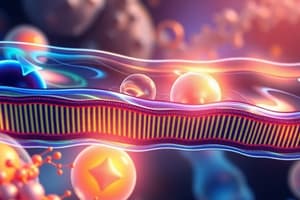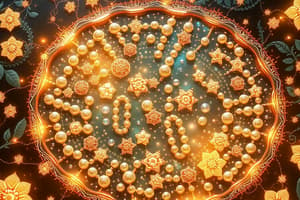Podcast
Questions and Answers
What is one primary function of the cell membrane?
What is one primary function of the cell membrane?
- To store genetic information
- To regulate what moves into and out of the cell (correct)
- To generate proteins
- To provide energy for cellular processes
Which component of the cell membrane can form glycoproteins when attached to proteins?
Which component of the cell membrane can form glycoproteins when attached to proteins?
- Proteins
- Cholesterol
- Phospholipids
- Carbohydrate chains (correct)
Which model describes the structure of the cell membrane?
Which model describes the structure of the cell membrane?
- Solid matrix model
- Rigid bilayer model
- Fluid mosaic model (correct)
- Static layer model
Which statement about the phospholipid bilayer is correct?
Which statement about the phospholipid bilayer is correct?
What type of permeability does the cell membrane exhibit?
What type of permeability does the cell membrane exhibit?
What role do proteins play in the cell membrane structure?
What role do proteins play in the cell membrane structure?
In terms of movement, how can the transport across the cell membrane be classified?
In terms of movement, how can the transport across the cell membrane be classified?
Which of the following statements about cholesterol in the cell membrane is true?
Which of the following statements about cholesterol in the cell membrane is true?
What is the main role of phospholipids in the cell membrane?
What is the main role of phospholipids in the cell membrane?
Which type of protein spans the entire cell membrane?
Which type of protein spans the entire cell membrane?
What property does cholesterol provide to the cell membrane?
What property does cholesterol provide to the cell membrane?
In the context of the membrane, what is the function of proteins?
In the context of the membrane, what is the function of proteins?
Which type of molecules can diffuse through the phospholipid bilayer?
Which type of molecules can diffuse through the phospholipid bilayer?
What do glycoproteins and glycolipids primarily serve in the cell membrane?
What do glycoproteins and glycolipids primarily serve in the cell membrane?
What does 'partially permeable' mean in the context of a cell membrane?
What does 'partially permeable' mean in the context of a cell membrane?
What defines a peripheral protein in relation to the cell membrane?
What defines a peripheral protein in relation to the cell membrane?
Flashcards
Cell Membrane Function
Cell Membrane Function
The cell membrane controls what enters and leaves the cell.
Partially Permeable Membrane
Partially Permeable Membrane
A membrane that only allows specific molecules to pass through.
Fluid Mosaic Model
Fluid Mosaic Model
A model that describes the structure of the cell membrane, showing proteins embedded within a phospholipid bilayer.
Phospholipid Bilayer
Phospholipid Bilayer
Signup and view all the flashcards
Hydrophilic Head
Hydrophilic Head
Signup and view all the flashcards
Hydrophobic Tail
Hydrophobic Tail
Signup and view all the flashcards
Protein Channels
Protein Channels
Signup and view all the flashcards
Cell Membrane Components
Cell Membrane Components
Signup and view all the flashcards
Glycoproteins
Glycoproteins
Signup and view all the flashcards
Glycolipids
Glycolipids
Signup and view all the flashcards
Integral Protein
Integral Protein
Signup and view all the flashcards
Extrinsic Protein
Extrinsic Protein
Signup and view all the flashcards
Peripheral Protein
Peripheral Protein
Signup and view all the flashcards
Fluid Mosaic Model
Fluid Mosaic Model
Signup and view all the flashcards
Phospholipids
Phospholipids
Signup and view all the flashcards
Lipid Bilayer
Lipid Bilayer
Signup and view all the flashcards
Membrane Fluidity
Membrane Fluidity
Signup and view all the flashcards
Lipid-soluble molecules
Lipid-soluble molecules
Signup and view all the flashcards
Protein Pores
Protein Pores
Signup and view all the flashcards
Cholesterol
Cholesterol
Signup and view all the flashcards
Glycoproteins/Glycolipids
Glycoproteins/Glycolipids
Signup and view all the flashcards
Partially Permeable
Partially Permeable
Signup and view all the flashcards
Plasma Membrane
Plasma Membrane
Signup and view all the flashcards
Hydrophilic
Hydrophilic
Signup and view all the flashcards
Hydrophobic
Hydrophobic
Signup and view all the flashcards
Study Notes
Cell Membrane Structure
- The cell membrane is a barrier between the cell's contents and the environment, found in all cells and organelles.
- It regulates what enters and exits the cell.
- The membrane is partially permeable (allows some molecules to pass through).
- The fluid mosaic model describes the structure.
- Phospholipids form a bilayer, with hydrophilic heads facing water and hydrophobic tails facing away.
- Proteins are scattered within this bilayer, forming a "mosaic" pattern.
Component Roles
- Phospholipids: Form the lipid bilayer, creating a barrier to water; allow lipid-soluble molecules to diffuse through.
- Proteins: Have various functions; act as channels, carriers, pumps for water-soluble molecules and ions; can be enzymes, electron carriers, hormone receptors, or binding sites for cell-to-cell communication.
- Cholesterol: Provides stability and prevents the membrane from breaking up.
- Glycoproteins/Glycolipids: Act as recognition and binding sites, involved in cell-cell recognition, communication, and receptor function, located on the outer surface of the membrane.
Further Considerations
- The structure is a model, observed with electron microscopes.
- Molecules can move across membranes via passive or active transport.
- Integral proteins span the membrane; peripheral proteins are on one side.
- Different molecules diffuse through different parts of the membrane (lipid soluble, water soluble).
Studying That Suits You
Use AI to generate personalized quizzes and flashcards to suit your learning preferences.




